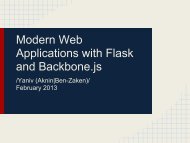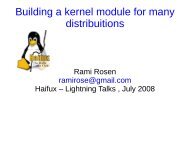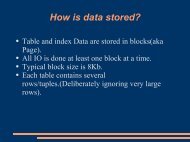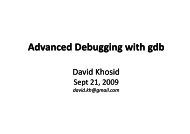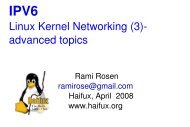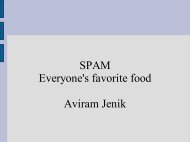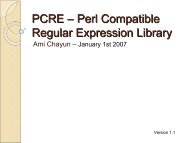OpenCL Do's and Don'ts
OpenCL Do's and Don'ts
OpenCL Do's and Don'ts
- No tags were found...
Create successful ePaper yourself
Turn your PDF publications into a flip-book with our unique Google optimized e-Paper software.
<strong>OpenCL</strong> Do’s <strong>and</strong> Don’tsOfer RosenbergPMTS, <strong>OpenCL</strong> SW Dev.19/12/2011
DispatchDispatchApplication code do’s <strong>and</strong> don’tsUse <strong>OpenCL</strong> where its right• Analyze the application code to find “hotspots”• The hotspot code should be:• Highly Parallelized• Each instance is independent• Remember the dispatch overhead• GPU ~ a few 10us• CPU also got “dispatch” overheadActual WorkActual Work2 | <strong>OpenCL</strong> Software | <strong>OpenCL</strong> Do’s <strong>and</strong> Don’ts | 12/2011
1024Application code do’s <strong>and</strong> don’tsChoosing the work size• Global – use the largest possible• Local – it’s complicated • Meet algorithm requirements on behavior• Key element for optimization on GPU• On CPU relevant only if there are barriers (fiber switch)• Too large – register spill to memory, cache misses, etc.1024• Too small – inefficient use of local memory, not hidinglatency• No rule of thumb here – need experiments3 | <strong>OpenCL</strong> Software | <strong>OpenCL</strong> Do’s <strong>and</strong> Don’ts | 12/2011
Memory Allocation• Choose the right type based onusage <strong>and</strong> device• USE_HOST_PTR is highly suitablefor CPU only execution• ALLOC_HOST_PTR is highly suitablefor multi-device execution• Some HW vendors offer specialmodesTable taken from AMD APP Programming guidehttp://developer.amd.com/sdks/amdappsdk/assets/AMD_Accelerated_Parallel_Processing_<strong>OpenCL</strong>_Programming_Guide.pdf4 | <strong>OpenCL</strong> Software | <strong>OpenCL</strong> Do’s <strong>and</strong> Don’ts | 12/2011
Memory Access• <strong>OpenCL</strong> supports two patterns of Memory Access:• Write/Execute/Read• Unmap/Execute/Map• Choosing a pattern is based on Application needs – the goal is tominimize copies/allocations. Examples:• If the Application receives <strong>and</strong> sends buffers with varying addresses,choose read <strong>and</strong> writes• If the Application processes the buffer (for example, analyze it),choose map/unmap to avoid additional memory allocation• Caution! Asynchronous operationclEnqueueRead/Write/Map/Unmap (queue, object, blocking, offset, size, *ptr, ...)• Choose “blocking” to ensure memory is copied when the operation isdone• Otherwise, monitor the event… (using “wait for event”, or eventcallback)5 | <strong>OpenCL</strong> Software | <strong>OpenCL</strong> Do’s <strong>and</strong> Don’ts | 12/2011
Asynchronous Copy (Transfer)• Relevant only for GPUs (or non-Host devices)• Available on some Vendor solutions (HW/SW)• The basic idea is overlap of data transfer <strong>and</strong> code executionWithoutAsync CopyDataTransferCodeExecutionDataTransferCodeExecutionDataTransferCodeExecutionWithAsync CopyQ2Q1DataTransferCodeExecutionDataTransferCodeExecutionDataTransferCodeExecution• How to enable Async Copy ?• Use two queues, one for data transfer <strong>and</strong> one for execution• Create the right event dependency between them• The SW & HW will utilize Async Copy automatically6 | <strong>OpenCL</strong> Software | <strong>OpenCL</strong> Do’s <strong>and</strong> Don’ts | 12/2011
The following slides are taken fromAMD <strong>OpenCL</strong> University Kithttp://developer.amd.com/zones/openclzone/universities/pages/default.aspxPerhaad Mistry & Dana Schaa,Northeastern University Computer Architecture Research Lab,with Benedict R. Gaster, AMD© 20117 | <strong>OpenCL</strong> Software | <strong>OpenCL</strong> Do’s <strong>and</strong> Don’ts | 12/2011
N-body Simulation• An n-body simulation is a simulationof a system of particles under theinfluence of physical forces likegravity• E.g.: An astrophysical systemwhere a particle represents agalaxy or an individual star• N 2 particle-particle interactions• Simple, highly data parallelalgorithm• Allows us to explore optimizations ofboth the algorithm <strong>and</strong> itsimplementation on a platformSource: THE GALAXY-CLUSTER-SUPERCLUSTER CONNECTIONhttp://www.casca.ca/ecass/issues/1997-DS/West/west-bil.html8 | <strong>OpenCL</strong> Software | <strong>OpenCL</strong> Do’s <strong>and</strong> Don’ts | 12/20118
Algorithm• The gravitational attraction between two bodies in space is an example of anN-body problem• Each body represents a galaxy or an individual star, <strong>and</strong> bodies attract each otherthrough gravitational force• Any two bodies attract each other through gravitational forces (F)•• An O(N 2 ) algorithm since N*N interactions need to be calculated• This method is known as an all-pairs N-body simulation9 | <strong>OpenCL</strong> Software | <strong>OpenCL</strong> Do’s <strong>and</strong> Don’ts | 12/20119
Basic Implementation – All pairs• All-pairs technique is used tocalculate close-field forces• Why bother, if infeasible forlarge particle counts ?• Algorithms like Barnes Hutcalculate far field forces usingnear-field results• Near field still uses all pairs• So, implementing all pairsimproves performance of bothnear <strong>and</strong> far field calculations• Easy serial algorithm• Calculate force by each particle• Accumulate of force <strong>and</strong>displacement in result vectorfor(i=0; i
All Pairs – full implementationVoid NBody::nBodyCPUReference(){//Iterate for all samplesfor(int i = 0; i < numBodies; ++i){int myIndex = 4 * i;float acc[3] = {0.0f, 0.0f, 0.0f};for(int j = 0; j < numBodies; ++j){float r[3];int index = 4 * j;float distSqr = 0.0f;for(int k = 0; k < 3; ++k){r[k] = refPos[index + k] - refPos[myIndex + k];distSqr += r[k] * r[k];}float invDist = 1.0f / sqrt(distSqr + espSqr);float invDistCube = invDist * invDist * invDist;float s = refPos[index + 3] * invDistCube;}for(int k = 0; k < 3; ++k) { acc[k] += s * r[k]; }}}for(int k = 0; k < 3; ++k){refPos[myIndex + k] += refVel[myIndex + k] * delT + 0.5f * acc[k] * delT * delT;refVel[myIndex + k] += acc[k] * delT;}11 | <strong>OpenCL</strong> Software | <strong>OpenCL</strong> Do’s <strong>and</strong> Don’ts | 12/2011
Parallel Implementation• Forces of each particle can becomputed independentlyN = No. of particles in system• Accumulate results in local memoryN• Add accumulated results toprevious position of particles• New position used as input to thenext time step to calculate newforces acting between particlesNForce betweenall particlesResultantforce – perparticleNext Iteration12 | <strong>OpenCL</strong> Software | <strong>OpenCL</strong> Do’s <strong>and</strong> Don’ts | 12/201112
H<strong>and</strong>s on #1Application code envelope is provided.Partial kernel called “NBody_Kernels_basic.cl” is provided1. Use the basic implementation on previous slide to create<strong>OpenCL</strong> Kernel that implements N-body2. Run on CPU device <strong>and</strong> GPU device, <strong>and</strong> compare3. The code uses device-local buffers, <strong>and</strong> copy. Convert toUSE_HOST_PTR <strong>and</strong> Map/Unmap, run the two versions onthe CPU <strong>and</strong> compare13 | <strong>OpenCL</strong> Software | <strong>OpenCL</strong> Do’s <strong>and</strong> Don’ts | 12/2011
Naïve Parallel ImplementationDisadvantages of implementationwhere each work item reads dataindependently• No reuse since redundantreads of parameters formultiple work-items• Memory access= N reads*Nthreads= N 2Similar to naïve non blockingmatrix multiplication in Lecture 5p items/workgroup__kernel void nbody(__global float4 * initial_pos,__global float4 * final_pos,Int N, __local float4 * result) {}int localid = get_local_id(0);int globalid = get_global_id(0);result [localid] = 0;for( int i=0 ; i
N/p work groupsLocal Memory Optimizationsp forces read into local memoryp• Data Reuse• Any particle read into compute unit canbe used by all p bodies• Computational tile:p items perworkgroupp• Square region of the grid of forcesconsisting of size p• 2p descriptions required to evaluate all p 2interactions in tile• p work items (in vertical direction) readin p forces• Interactions on p bodies captured as anupdate to p acceleration vectors• Intra-work group synchronization shownin orange required since all work itemsuse data read by each work itemppptile 0 tile 1 tile N/ptile 0tile 1 tile N/p15 | <strong>OpenCL</strong> Software | <strong>OpenCL</strong> Do’s <strong>and</strong> Don’ts | 12/201115
H<strong>and</strong>s on #2Application code <strong>and</strong> kernel code for tiled access is provided1. Use the description to convert the kernel to use localmemory2. Run on CPU device <strong>and</strong> GPU device, with <strong>and</strong> without localmemory <strong>and</strong> compare16 | <strong>OpenCL</strong> Software | <strong>OpenCL</strong> Do’s <strong>and</strong> Don’ts | 12/2011
<strong>OpenCL</strong> Implementation• Data reuse using local memory• Without reuse N*p items read perwork group• With reuse p*(N/p) = N items readper work group• All work items use data read in byeach work item• SIGNIFICANT improvement: p iswork group size (at least 128 in<strong>OpenCL</strong>, discussed in occupancy)• Loop nest shows how a work itemtraverses all tiles• Inner loop accumulates contributionof all particles within tilefor (int i = 0; i < numTiles; ++i){// load one tile into local memoryint idx = i * localSize + tid;localPos[tid] = pos[idx];}}barrier(CLK_LOCAL_MEM_FENCE);// calculate acceleration effect due to each bodyfor( int j = 0; j < localSize; ++j ) {// Calculate acceleration caused by particle j on ifloat4 r = localPos[j] – myPos;float distSqr = r.x * r.x + r.y * r.y + r.z * r.z;float invDist = 1.0f / sqrt(distSqr + epsSqr);float s = localPos[j].w * invDistCube;// accumulate effect of all particlesacc += s * r;}// Synchronize so that next tile can be loadedbarrier(CLK_LOCAL_MEM_FENCE);17 | <strong>OpenCL</strong> Software | <strong>OpenCL</strong> Do’s <strong>and</strong> Don’ts | 12/201117
Performance - Loop Unrolling• We also attempt loop unrolling of the reuse local memoryimplementation• We unroll the innermost loop within the thread• Loop unrolling can be used to improve performance by removingoverhead of branching• However this is very beneficial only for tight loops where the branchingoverhead is comparable to the size of the loop body• Experiment on optimized local memory implementation• Executable size is not a concern for GPU kernels• We implement unrolling by factors of 2 <strong>and</strong> 4 <strong>and</strong> we seesubstantial performance gains across platforms• Decreasing returns for larger unrolling factors seen18 | <strong>OpenCL</strong> Software | <strong>OpenCL</strong> Do’s <strong>and</strong> Don’ts | 12/2011Perhaad Mistry & Dana18
Provided Nbody Example• A N-body example is provided forexperimentation <strong>and</strong> explore GPUoptimization spaces• St<strong>and</strong>-alone application based onsimpler on AMD SDK formulation• Three kernels provided• Simplistic formulation• Using local memory tiling• Using local memory tiling with unrolling• Note: Code is not meant to be a highperformance N-body implementation in<strong>OpenCL</strong>• The aim is to serve as an optimizationbase for a data parallel algorithmScreenshot of provided N-body demorunning 10k particles on a AMD 587019 | <strong>OpenCL</strong> Software | <strong>OpenCL</strong> Do’s <strong>and</strong> Don’ts | 12/201119



